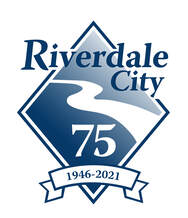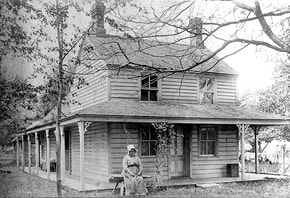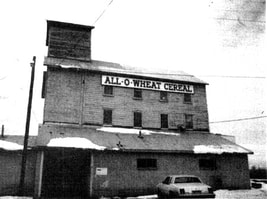RIVERDALE CITY HISTORY
RIVERDALE CELEBRATES 75TH ANNIVERSARY OF INCORPORATION
Riverdale was incorporated as a town on March 4, 1946. This year, we proudly celebrate the 75th Anniversary of our incorporation. Join us as we celebrate Riverdale City's 75th anniversary of incorporation with a variety of events which include: Video Presentation, New City Logo, 75 Mile Challenge, and Riverdale 75 Scavenger Hunt. Information about each of these is listed below.
Anniversary Video
Please enjoy this Special video presentation.
Riverdale was incorporated as a town on March 4, 1946. This year, we proudly celebrate the 75th Anniversary of our incorporation. Join us as we celebrate Riverdale City's 75th anniversary of incorporation with a variety of events which include: Video Presentation, New City Logo, 75 Mile Challenge, and Riverdale 75 Scavenger Hunt. Information about each of these is listed below.
Anniversary Video
Please enjoy this Special video presentation.
New City Logo
A new city logo has also been designed to commemorate the 75th anniversary of incorporation. The rendition of the new design is shown above. The new logo will be used throughout the year to denote our diamond anniversary. Special thanks to city employee Baylee Cascaddan for creating the new logo.
A new city logo has also been designed to commemorate the 75th anniversary of incorporation. The rendition of the new design is shown above. The new logo will be used throughout the year to denote our diamond anniversary. Special thanks to city employee Baylee Cascaddan for creating the new logo.
75th Anniversary Art Contest
To view the 75th Anniversary Art winners click here.
Riverdale 75 Scavenger Hunt
Thank you to all who participated in the scavenger hunt. Please enjoy this short video of the event:
To view the 75th Anniversary Art winners click here.
Riverdale 75 Scavenger Hunt
Thank you to all who participated in the scavenger hunt. Please enjoy this short video of the event:
75 Mile Run, Walk, Roll Challenge
Thank you to all who participated!
75 Mile Run, Walk, Roll Challenge
Thank you to all who participated!
Additional information is coming. Check back soon!
EARLY HISTORY
Nomadic Shoshone, Ute, and prehistoric Indians favored the area for centuries, hunting in the mountains and foothills and fishing in the streams. Mounds near the confluence of the Weber and Ogden rivers contain remains of their camps.
American and British mountain men entered the area in the early 1800s, trapping beaver and trading with the Indians. In 1824 Jim Bridger became the first white man to report sighting the Great Salt Lake. Peter Skene Ogden traversed the high valley just behind the Wasatch Front in 1825 and is remembered in the name of the area's largest city--although he never visited the actual site. The first accurate maps of the area were drawn by John C. Fremont, after he visited the mouth of the Weber River in 1843.
Riverdale is situated in south central Weber County. It was once called "Stringtown" due to the early homes being strung along a single road and the Weber River. It was also known as "Jack Thompson's Settlement" and "Union" before the name of Riverdale was given to the town
The first settlers in the community were James Graham, his sons George and Robert, and other members of the family. They farmed in the area as early as 1850. Elisha Lane located nearby, as did William Farley, and Rufus Allen. Other early settlers of Riverdale included Adam Fife, Alexander Patterson, Warren C. Child, Thomas Slater, Richard Woolsey, John Child, John C. Thompson, William Stimpson, Myron Barber Child, and George Ritter
In 1853, Daniel Burch built a grist mill on the east side of the Weber River. Later he added a saw mill to rip logs and saw lumber for homes. The river bottoms were covered with cottonwood timber which supplied the lumber. In 1858, Apostle John Taylor of the L.D.S. Church, purchased the mill and made improvements, including the establishment of a carding machine. Richard Dye and Edward Stratton took charge of the grist mill and carding machine.
Other early industries included a blacksmith shop built in about 1860. Matches were manufactured by Hugh Findlay. He packaged them in pasteboard boxes of 200 and sold them for 25 cents a box. Milk was hauled in from the Morgan area and was processed at the Creamery. Settlers also enjoyed the convenience of a canning factory.
The pioneer settlers dug a canal taking water out of the Weber River near the eastern bend for the purpose of irrigating the bottom land. They raised hay, potatoes, vegetables, fruits, and sugar beets.
John Child was the first postmaster. Mail came once a week. Hugh Findlay was the first teacher in the log school house in 1858. The school house was located at about what is presently 1000 West 4400 South. In 1862, a larger log building was constructed, and then replaced by a rock school house in 1865. It served until 1900.
The population of Riverdale in 1878 was 211.
EARLY HISTORY
Nomadic Shoshone, Ute, and prehistoric Indians favored the area for centuries, hunting in the mountains and foothills and fishing in the streams. Mounds near the confluence of the Weber and Ogden rivers contain remains of their camps.
American and British mountain men entered the area in the early 1800s, trapping beaver and trading with the Indians. In 1824 Jim Bridger became the first white man to report sighting the Great Salt Lake. Peter Skene Ogden traversed the high valley just behind the Wasatch Front in 1825 and is remembered in the name of the area's largest city--although he never visited the actual site. The first accurate maps of the area were drawn by John C. Fremont, after he visited the mouth of the Weber River in 1843.
Riverdale is situated in south central Weber County. It was once called "Stringtown" due to the early homes being strung along a single road and the Weber River. It was also known as "Jack Thompson's Settlement" and "Union" before the name of Riverdale was given to the town
The first settlers in the community were James Graham, his sons George and Robert, and other members of the family. They farmed in the area as early as 1850. Elisha Lane located nearby, as did William Farley, and Rufus Allen. Other early settlers of Riverdale included Adam Fife, Alexander Patterson, Warren C. Child, Thomas Slater, Richard Woolsey, John Child, John C. Thompson, William Stimpson, Myron Barber Child, and George Ritter
In 1853, Daniel Burch built a grist mill on the east side of the Weber River. Later he added a saw mill to rip logs and saw lumber for homes. The river bottoms were covered with cottonwood timber which supplied the lumber. In 1858, Apostle John Taylor of the L.D.S. Church, purchased the mill and made improvements, including the establishment of a carding machine. Richard Dye and Edward Stratton took charge of the grist mill and carding machine.
Other early industries included a blacksmith shop built in about 1860. Matches were manufactured by Hugh Findlay. He packaged them in pasteboard boxes of 200 and sold them for 25 cents a box. Milk was hauled in from the Morgan area and was processed at the Creamery. Settlers also enjoyed the convenience of a canning factory.
The pioneer settlers dug a canal taking water out of the Weber River near the eastern bend for the purpose of irrigating the bottom land. They raised hay, potatoes, vegetables, fruits, and sugar beets.
John Child was the first postmaster. Mail came once a week. Hugh Findlay was the first teacher in the log school house in 1858. The school house was located at about what is presently 1000 West 4400 South. In 1862, a larger log building was constructed, and then replaced by a rock school house in 1865. It served until 1900.
The population of Riverdale in 1878 was 211.






